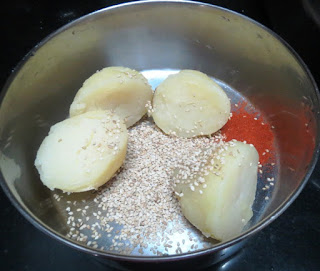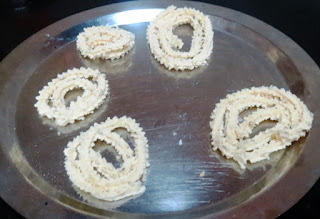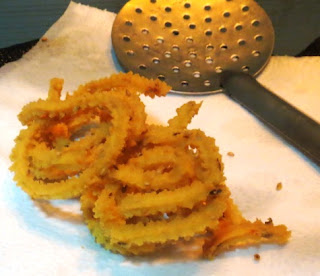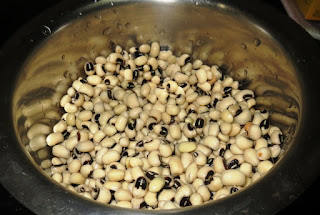Rasmalai is a sweet traditional dish and full of milk and dry fruits. It is one of my favourite dish too. Preparing this Rasmali, I just think of the time we spent in Dubai. Indeed it was just beautiful days.
Once me and my friends were very entu to present a dance (Kannad song) to one of the programme in Abhdhabi. I think it was one of the Kannada Vishwa Saahitya Sammelana hosted by Abudhabi Karnataka Sangha. Thanks to Sarvottama Shetty who is a good organiser and the head of Abudhabi Kannada Sangha who invited us to participate in the programme. I have gathered a group of people from our friend circle. Our friend who is a good Bharatha Natyam Dancer, Lakshmi Soory agreed to teach us dance. There was a shortage of dancers and one of our friend Lakshmi Srinath brought her friend's daughter Shwetha Ramesh to dance.This girl was also so entu like us and gave a good company for us. Not only learning dance, we had fun in preparing one dish and bringing it to the place wherever we used to practice. Nothing was in force condition but with love and affection. Our group really had good time spending and did the dance in beautiful way. That time Dr. V. S. Acharya and Kumara Swami and Actor Ramesh Aravind were present in the auditorium. These all things go down the memory line. But the Rasmalai we had which Roopa Ramesh prepared keep coming back again and again. One of our dishout programme Roopa Ramesh brought these delicious rasmalais. It was yummy and we had as many as we wanted. So I have collected the recipe from her and since that time I wanted to try this "Easy Rasmali". Got the chance to prepare now.
I have used Mayya's ready to eat "Rasgulla". Now you must have got the idea how one can prepare Rasmalai in an easy method. I like Mayya's product. It is like home made and I am 100% sure it is hygiene. They do take precautions while preparing. As their head line says Mayya's Products are made with love.
Coming back to the recipe of Rasamalai, There are 10 Rasgullas in a tin which cost about Rs. 70. So 10 Rasamalais can be prepared with one tin of Rasgulla.
You can prepare this Rasmalai for kids party, Ladies Kitty Party, for festival or feast. Give a try and you will love them.
Things needed :
Mayya's Rasgulla Tin : 1
Milk : 1/2 Litre
Sugar : 2 Tablespoon
Cardamom : 2 to 3 Pods
Almonds : 10 to 12 or more
Cashews : 5 to 6
Saffron rakes : 3 to 4.
Method :
1. Keep milk for boiling on low flame. Add sugar and mix it well. Let it boil for 10 minutes. Stir in between. Remove from the fire and allow it to cool. Add saffron's rake.
2. Powder cardamom and add it to the milk.
3. Cut almonds and cashews into small pieces
4. Open Mayya's Rasgulla Tin with the help of opener and put it in a big bowl.
5. Separate the sugar syrup and keep the Rasgulla in a separate plate.
6. Now squeeze out sugar syrup from rasgulla one by one. (Keep a rasgulla on your palm and press it with other hand and remove the sugar syrup). Keep them in a plate.
7. Put cooled boiled milk in a serving dish. Add squeezed Rasgullas. Add cut almonds and cashews on the top.
8. Allow it to set for 20 minutes. (You can keep it in fridge).
9. Rasmalai is ready to serve.
Note :
You can adjust sugar according to your taste.(more/less). Better not to use the sugar syrup which is in the tin.(optional). Adding more almonds is optional. Roasting almonds and cashews is also optional.
Time : 40 minutes.
Serves : 4 to 5
Once me and my friends were very entu to present a dance (Kannad song) to one of the programme in Abhdhabi. I think it was one of the Kannada Vishwa Saahitya Sammelana hosted by Abudhabi Karnataka Sangha. Thanks to Sarvottama Shetty who is a good organiser and the head of Abudhabi Kannada Sangha who invited us to participate in the programme. I have gathered a group of people from our friend circle. Our friend who is a good Bharatha Natyam Dancer, Lakshmi Soory agreed to teach us dance. There was a shortage of dancers and one of our friend Lakshmi Srinath brought her friend's daughter Shwetha Ramesh to dance.This girl was also so entu like us and gave a good company for us. Not only learning dance, we had fun in preparing one dish and bringing it to the place wherever we used to practice. Nothing was in force condition but with love and affection. Our group really had good time spending and did the dance in beautiful way. That time Dr. V. S. Acharya and Kumara Swami and Actor Ramesh Aravind were present in the auditorium. These all things go down the memory line. But the Rasmalai we had which Roopa Ramesh prepared keep coming back again and again. One of our dishout programme Roopa Ramesh brought these delicious rasmalais. It was yummy and we had as many as we wanted. So I have collected the recipe from her and since that time I wanted to try this "Easy Rasmali". Got the chance to prepare now.
I have used Mayya's ready to eat "Rasgulla". Now you must have got the idea how one can prepare Rasmalai in an easy method. I like Mayya's product. It is like home made and I am 100% sure it is hygiene. They do take precautions while preparing. As their head line says Mayya's Products are made with love.
Coming back to the recipe of Rasamalai, There are 10 Rasgullas in a tin which cost about Rs. 70. So 10 Rasamalais can be prepared with one tin of Rasgulla.
You can prepare this Rasmalai for kids party, Ladies Kitty Party, for festival or feast. Give a try and you will love them.
Things needed :
Mayya's Rasgulla Tin : 1
Milk : 1/2 Litre
Sugar : 2 Tablespoon
Cardamom : 2 to 3 Pods
Almonds : 10 to 12 or more
Cashews : 5 to 6
Saffron rakes : 3 to 4.
Method :
1. Keep milk for boiling on low flame. Add sugar and mix it well. Let it boil for 10 minutes. Stir in between. Remove from the fire and allow it to cool. Add saffron's rake.
2. Powder cardamom and add it to the milk.
3. Cut almonds and cashews into small pieces
4. Open Mayya's Rasgulla Tin with the help of opener and put it in a big bowl.
5. Separate the sugar syrup and keep the Rasgulla in a separate plate.
6. Now squeeze out sugar syrup from rasgulla one by one. (Keep a rasgulla on your palm and press it with other hand and remove the sugar syrup). Keep them in a plate.
7. Put cooled boiled milk in a serving dish. Add squeezed Rasgullas. Add cut almonds and cashews on the top.
8. Allow it to set for 20 minutes. (You can keep it in fridge).
9. Rasmalai is ready to serve.
Note :
You can adjust sugar according to your taste.(more/less). Better not to use the sugar syrup which is in the tin.(optional). Adding more almonds is optional. Roasting almonds and cashews is also optional.
Time : 40 minutes.
Serves : 4 to 5






































